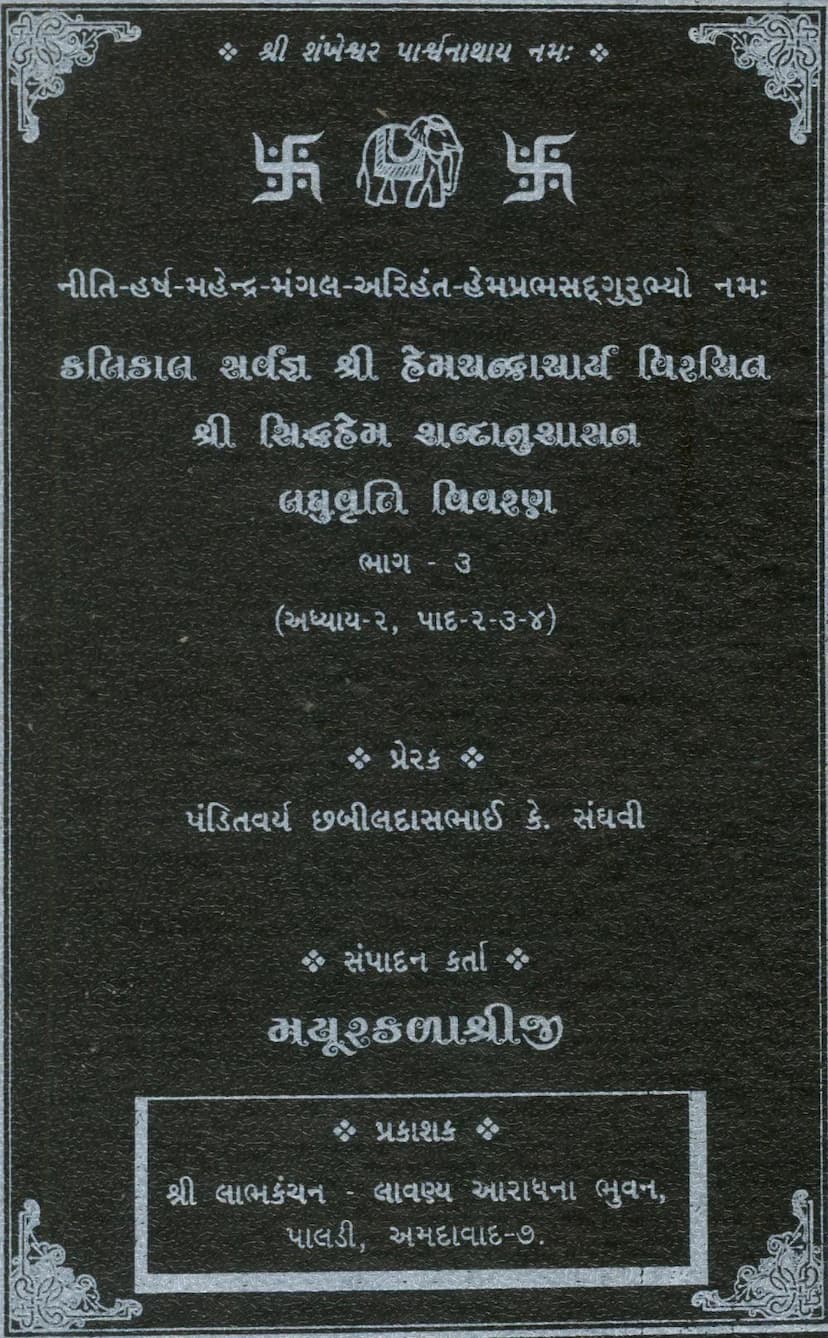Siddhhem Shabdanushasan Laghuvrutti Vivran Part 03
Added to library: September 2, 2025

Summary
Based on the provided pages, here's a comprehensive summary of "Siddhhem Shabdanushasan Laghuvrutti Vivran Part 03" by Mayurkalashreeji, focusing on the content and purpose of this specific volume:
Title: Siddhhem ShabdanushDhan Laghuvrutti Vivran Part 03 (सिद्धहेम शब्दानुशासन लघुवृत्ति विवरम् भाग 3) Author/Editor: Mayurkalashreeji (मयूरकलाश्रीजी) Publisher: Labh Kanchan Lavanya Aradhan Bhuvan (श्री लाभकंचन - लावण्या आराधना भुवन) Key Focus of Part 03: This volume covers Chapters 2, Sections 2, 3, and 4 of the Siddhhem Shabdanushasan grammar. Specifically, it delves into sections related to Karak (कारक), Vibhakti (विभक्ति) (case endings), Ling (लिंग) (gender), and Sandhi (सन्धि), although the page count heavily leans towards Karak and Vibhakti.
Core Purpose and Content:
- Elaboration of Hemachandracharya's Siddhhem Shabdanushasan: This book is a detailed commentary (Laghuvrutti Vivran) on the foundational grammar text of Jainism, the Siddhhem Shabdanushasan, authored by Acharya Hemachandracharya. The "Vivran" aspect signifies an explanation or elaboration of the rules and concepts presented in the original grammar and its standard commentary (Laghuvrutti).
- Simplifying Complex Grammar: The primary goal of the "Vivran" is to make the intricate and often complex rules of Sanskrit grammar, as presented in Siddhhem Shabdanushasan, accessible to a wider audience. The editor, Mayurkalashreeji, aims to present these concepts in a way that facilitates easier study and understanding.
- Detailed Explanation of Karak and Vibhakti: A significant portion of this volume is dedicated to the Karak (कारक) rules, which explain the relationship between verbs and nouns (agents like the doer, the object, the instrument, etc.) and the resulting case endings (Vibhakti (विभक्ति)). It systematically breaks down the definitions, sutras (aphorisms), and examples for each of the six Karakas (Kartri, Karma, Karan, Sampradan, Apadan, Adhikaran).
- Explanation of Ling (Gender): The text also covers rules pertaining to Ling (लिंग), which dictate how words change based on gender (masculine, feminine, neuter).
- Explanation of Sandhi (Union of Sounds): While less prominent in the provided pages, the introduction mentions that previous volumes covered Sandhi (सन्धि) rules, and this volume is presented as part of a series that likely continues or expands upon these grammatical topics.
- Pedagogical Approach: The commentary adopts a clear, step-by-step approach. It explains the sutras, provides detailed explanations (Vivechan), addresses potential questions (Prashna), and illustrates concepts with examples. This suggests a focus on effective teaching and learning.
- Historical Context and Glorification of Siddhhem: Pages 5-9 provide a historical narrative about the creation of the Siddhhem Shabdanushasan, emphasizing its significance, the intellectual environment of Gujarat under King Siddharaj, and the endorsement of Hemachandracharya's grammar through a divine test (floating grammars in water). This section highlights the paramount importance and superiority of the Siddhhem grammar.
- Authorship and Spiritual Lineage: The preface and introductory pages highlight the lineage of the editor, Mayurkalashreeji, tracing her connection to prominent Jain Acharyas like Acharyadevshri Nitisurishwarji and Acharyadevshri Arihantsiddhasurishwarji, and her Guru, Sadhvi Shri Shanshashriji M.Sa., and her disciple, Sadhvi Shri Lavanyashriji M.Sa. This emphasizes the traditional and spiritual basis of the commentary.
Overall Significance:
This volume is an essential resource for students and scholars of Jainism and Sanskrit grammar who wish to deepen their understanding of Hemachandracharya's seminal work. It serves as a bridge, making the complex grammatical structures of the Siddhhem Shabdanushasan comprehensible through detailed explanations, historical context, and a structured approach. It highlights the enduring relevance and systematic nature of ancient Indian linguistic science within the Jain tradition.